Evaluation of Arsenic, Cadmium, and Chromium in Walnut (Carya illinoinensis) in an Agricultural Area of Chihuahua Mexico: Carcinogenic Risk Assessment
Angélica Cervantes Trejo1*, and Luz O Leal2
1Tecnológico Nacional de México Campus Chihuahua, Avenida Tecnológico 2909, Chihuahua 31310, Mexico
2Environment and Energy Department, Advanced Materials Research Center (CIMAV) S.C., Miguel de Cervantes 120, Chihuahua 31109, Mexico
Submission: July 18, 2023; Published: July 31, 2023
*Corresponding author: Angélica Cervantes Trejo, Tecnológico Nacional de México Campus Chihuahua, Avenida Tecnológico 2909, Chihuahua 31310, Mexico
How to cite this article: Angélica C T, Luz O L. Evaluation of Arsenic, Cadmium, and Chromium in Walnut (Carya illinoinensis) in an Agricultural Area of Chihuahua Mexico: Carcinogenic Risk Assessment. Agri Res & Tech: Open Access J. 2023; 27 (4): 556384. DOI: 10.19080/ARTOAJ.2023.27.556384
Abstract
This research aimed to quantify major and trace elements in walnut orchards (Carya illinoinensis) and assesses the exposure to toxic elements. Samples of irrigation water, soil, walnut leaves, and walnut were collected in two periods, October 2019 (rainy year) and October 2020 (drought year). A total of 108 samples were analyzed. The measurements were performed in ICP-OES. It was found that As (1.8-2.1 mg*kg-1), and Cd (0.15-0.18 mg*kg-1) in walnut were above the permissible limit in fruits. CR for As and Cr exceeds the threshold limit (CR>10-4). Besides, it was performed statistical analysis with the SAS system that shows that there are no significative differences in Cr in walnut comparing a rainy and drought years, also there is a translocation in walnut of As and Cd only in a year with rain, and finally in the drought year the Na in the leaves of the plant was observed to be four times greater than it was in the rainy year, indicating a possible tendency of hyperaccumulation of Na.
Keywords: Carcinogenic Risk (CR); Walnut; Drought; Arsenic; Cadmium; Chromium
Introduction
Determining the dynamics of heavy metals in water soil-plant interaction in fruits and vegetables is an important task for environmentalists and scientists [1,2]. Fruits are one of the most consumed foods, these are rich sources of vitamins and minerals. However, irrigation water and soils can be contaminated with trace elements (TEs) attributed to the increased use of chemicals, fertilizers, pesticides, herbicides, industrialization, mining activities, etc. The pollution of agricultural food with TEs is one of the most important aspects of food quality [3]. The TEs have drawn worldwide attention for their health risk implications, which are attributed TEs are non-biodegradable, harmful to living organisms, and further, they have accumulative and lasting capabilities [4]. According to number studies, the major exposure route of TEs is the ingestion of contaminated food [5]. In addition, the study of the content of TEs is of high importance, because allows the determining and analyzing the carcinogenic [5-7].
Nevertheless, researches on the implications for human health still remain insufficient [8]. On the other hand, the International Agency for Research on Cancer (2012) has classified arsenic (As), and cadmium (Cd) are both toxic (carcinogenic) elements [9], Chromium (Cr) is also a toxic element because chronic exposure to Cr can cause damage to liver, kidney, and stomach as well as cancer [10].
Walnut is one of the top four nuts, which are widely grown around the globe [10].The cultivation of walnut is very important for the economic impact in the northern region of Mexico. At an international level, Mexico produces 40.1% of walnut, which represents the second place internationally; the walnut-producing region of Chihuahua is the first place in national walnut production with an overall production of 65,500 tons, which represents 62.9% of the walnut produced in Mexico [11]. The walnut production region is located in the southeastern of Chihuahua State. The main aim of this study is to evaluate the concentrations and dynamics of major elements (Ca, Cu, Fe, K, Mg, Mn, Na, P, S, and Zn) and TEs (As, Cd, Cr, Pb, Sb, and Se) in the water, soil, and plant interaction; the research is studied in the Carya illinoinensis tree with the variety Western in two municipalities: San Francisco de Conchos and Camargo Chihuahua (four orchards). Finally, carcinogenic risk (CR) was estimated.
Materials and Methods
Study site choice
This study researched four orchards in two counties (San Francisco de Conchos, and Camargo) in the state of Chihuahua. In Figure 1, the study area and the sampling points are presented. The agricultural area has an annual precipitation average of 246.3 mm in San Francisco de Conchos, and 342.2 mm in Camargo CONAGUA [12], the rains are abundant from June to October, the annual mean temperature ranges between 18 to 20 °C. The research area is in an arid region, in the higher and lower areas of the Rio Conchos Watershed of southeastern Chihuahua [13]. The Rio Conchos is a major tributary of the Rio Grande/Rio Bravo, basin contributes 54% (897.61 hm3/year) of the flow [14].
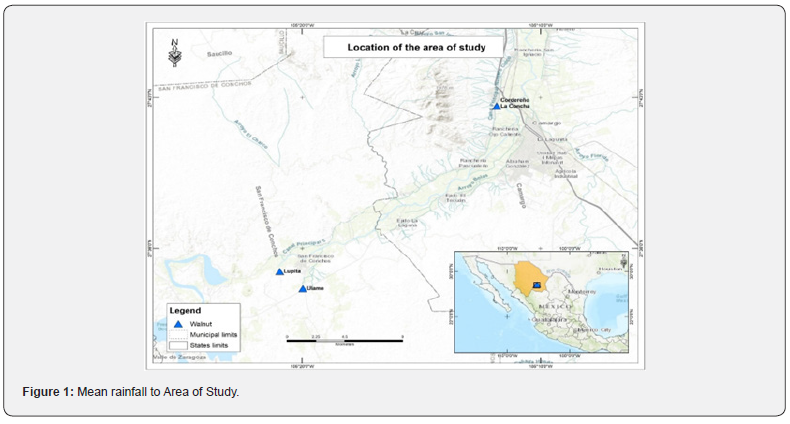
Sampling
This research was performed in four walnut orchards: Lupita and Ulame in San Francisco de Conchos, and Cordereño and La Concha in Camargo, both places in the state of Chihuahua in Mexico. The sample recollection was performed prior to the harvest of the walnut in October 2019 for Lupita and Ulame, and in October 2020 for Cordereño and La Concha. It was recollected samples of soil, walnut tree leaves, water, and walnuts in each walnut orchard; it was collected 108 samples for two years (2019 and 2020). Irrigation water was sampled from the surface water of the Rio Conchos River. The water was stored in 1-L tanks. It was measured pH, and electrical conductivity (EC) In-situ for soil and water. Soil samples were taken from an area of 30 x 30 cm at a depth of 0-30 cm. Samples of 1 kg of soil, leaves, and walnuts were collected in a plastic bag for further analysis in the laboratory. In addition, these samples were air-dried, crushed to a fine powder (200 mesh), and homogenized. Leaves and walnut samples were first thoroughly washed with tap water, and finally with deionized water, to remove impurities. In walnut samples, the shell was separated. Subsequently, samples of leaves, walnuts, and shells were ground in a glass mortar and sieved to obtain a fine powder. Finally, samples of soil, leaves, walnuts, and shells were dried in an oven at 70 ± 5 °C for 24 h.
Experimental Procedure
It was weighted samples of soil (500mg), walnut leaves (200 mg), shell (250 mg), walnut (250 mg), and irrigation water (45 mL) were taken and transferred to a poly vial. The samples were subjected to acid digestion by using different reagents. For soils, leaves, and irrigation water 9 mL of HNO3 (69-70 % J.T. Baker Instra-Analyzed) and 3 mL of HCl (36.5-38% J.T. Baker Instra- Analyzed) were added to the sample. The walnut and shells were added 9 mL of HNO3 (69-70 %J.T. Baker Instra-Analyzed) and 1 mL H2O2 (30% J.T. Baker) was added to the sample. The containers were put into a microwave MARS Xpress (CEM) sample digestion.
Then the containers were cooled at room temperature, and the samples were recovered by filtration in 50 mL class A volumetric flasks, then brought to 50 mL with Mili-Q water. The detector used in this work was an ICP-OES IcapTM 7000 series, manufactured by Thermo ScientificTM with an Ultrasonic Nebulizer CETAC U5000AT+.
Statistical Analysis
To compare the average of the concentrations in a year with drought and a year with precipitation, a statistical analysis was carried out. The procedure in SAS 9 (SAS Institute, Cary, NC, USA) was used to obtain the ANOVA and a student t-test was performed for Reference Material Certificated.
Estimated Walnut Consumption
For this study, to evaluate the carcinogenic risk assessment, it is calculated an estimated daily intake (EDI) of walnut using formula 1 [15,16].
EDI= C x IR x EF x ED / (Bw x AT) (1)
The formula parameters are as follows: C is the average quantity of the contaminant in mg/kg, IR is the daily ingestion of walnut in kg/day, EF is the exposure rate (365 days/year), ED is the exposure duration (70 years). BW is the average bodyweight of the person exposed to the walnut ingestion (72 kg), AT is the time over which the dose is averaged, in this study it is considered an AT of 25,550 days (70 years) [17].
Carcinogenic Risk Assessment
Carcinogenic risk for TEs (As, Cd, and Cr) was estimated via the model described by EPA [18].
CR = SF x EDI
The CR is the lifetime carcinogenic risk of a person, while SF (slope factor) is the likelihood of an individual for developing cancer from exposure to the trace element. In table 1 it is shown the SF for the trace elements that are being evaluated for the carcinogenic risk in study [5]. The safe limit threshold is CR < 10-6, CR of 10-6 to 10-4 is considered an acceptable level of cancer risk, and CR > 10-4 is the threshold limit that is not allowable [19].
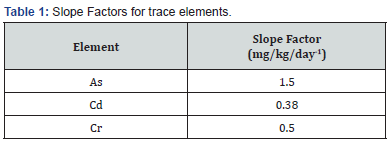
Results and Discussion
Concentration of Major and Trace Elements in Soil and Irrigation Water
The parameters measured In situ in soil and irrigation water in the study area are presented in Table 2. In irrigation water that belongs to Rio Conchos, used in the orchards Lupita and Ulame, the pH presented tends to be neutral (7.05-7.10), however, the pH values from Cordereño and La Concha showed values of 8.14 to 8.18, with a tendency to alkaline value. In addition, the minimum value of pH in soil was 7.84 and the maximum value was 8.47, which is slightly alkaline values. The availability of toxic elements, such as As, Cd, Cr, Sb, Se, and Pb in irrigation water and soil is responsible for the global increase of TEs in agriculture, which is attributed to the transfer of these elements from the water to the soil, but also for plants and therefore also to fruits and vegetables [20].

The physicochemical parameters such as EC and pH may affect the solubility and the translocation of TEs in trees and plants [21]. EC in irrigation water in the orchards Lupita and Ulame, showed values from 0.687 to 0.688 mS/cm, the sampling of these orchards was in a year whit high precipitation (2019). On the other hand, the values of EC in irrigation water in Cordereño and La Concha were found in a range between 1.078 and 1.044 mS/cm, these values did exceed the degree of restriction of 0.7 mS/cm, besides, the greater the conductivity, the greater is its salt content, water in the semiarid and arid regions has generally higher salinity [22], also these orchards were sampled in a year with drought (2020), the harvest at Cordereño and La Concha were considered unsuccessful with poor walnut quality, associated with low rainfall. Otherwise, EC in the soil showed values from 0.166 to 0.400 mS/cm an indication of non-saline soils.
The results of concentrations of TEs in irrigation water (Table 3) analyzed in this research were below according to the legislation of FAO and CONAGUA (responsible to control, manage, and protect national water in Mexico). At present, there is no legislation for TEs in agricultural soils. Nevertheless, the dynamic and transference of toxic elements from soil to plants is a pathway of pollution for fruits and vegetables [23]. The results in Table 3, show high concentrations of Na in soil, the range was from 10,080 to 10,881 mg/kg-1 in the orchards Cordereño and La Concha, this analyte is responsible for the decrease in permeability or water infiltration through the soil, physically degrading it, and therefore decreasing crop yield [24]. The results are the mean of soil of the four walnut orchards. Besides, Na was found higher, in the soil of Cordereño and La Concha orchards in the 2020 collection, in comparison to 2019 sampling of Lupita and Ulame orchards.
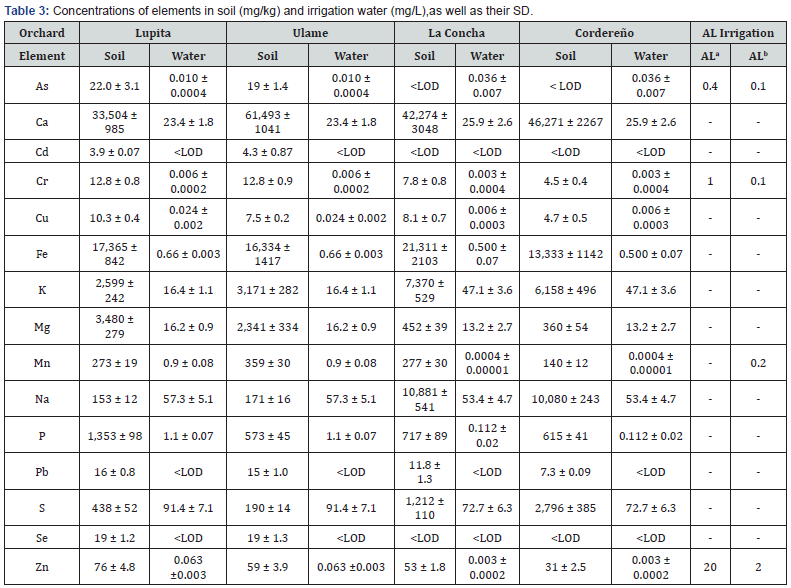
Note: Data is the mean of n=7. Sb was not detected.
ALa = Allowed limit by CONAGUA (CONAGUA, 2013).
ALb = Allowed limit by FAO (FAO, 1985). LOD = result lower than the detection limits of ICP-OES - there is no allowed limit established by agencies.
Note: Data are the mean of n=7.
Cd, Pb, Sb, and Se were not found in irrigation water
Concentration of Major and Trace Elements in Walnuts and Shells
The concentrations of 13 elements in walnut and shell were determined and presented in Table 4. From the results of walnut, it can be observed As, Cd, and Cd are detected in walnut in the orchards Lupita and Ulame. On the other hand, the TEs Pb, Sb, and Se were not detected in the walnut and shell. Major and TEs in the environment can enter the fruits and vegetables through different pathways during their agricultural growth, with a health risk concern. Therefore, measuring and reporting the TEs concentrations is important to give information to the population.
In Table 3, it can be observed that the concentration of As in walnut in the orchards Lupita and Ulame ranged from 1.8 to 2.1 mg* kg-1 and ranged from 1.29 to 1.54 mg*kg-1 in the shell. These values of As exceeded the maximum allowable level of 0.05 mg*kg-1 in fruits by FAO. In the literature, As in walnut was found in China an interval of concentration from 0.0005 to 0.1mg*kg-1 [10], moreover, in Italy As values of 0.045 to 0.119 were reported in fruits-vegetables (Cucumbers, aubergines, peppers, pumpkins, courgettes) [25]. In the same way, the analyte of Cd in this research of walnut was found in the range of concentration of 0.15 to 0.18 mg*kg-1 in the orchards Lupita and Ulame, these values are above the allowable limit of Cd in fruits of 0.05 mg*kg-1 [26]. A study in Germany reported in walnut a value of 0.0007 mg*kg-1 of Cd [27], in addition to, values of Cd have been reported for walnut in China of 0.003 mg*kg-1 [10], and 0.020 to 0.003 mg*kg-1 [28]. In these studies, around the globe values of As and Cd are lower than the concentrations in this research. The high value of Cd in walnut in this research can be attributed to the application of agrochemicals in the orchards. In the orchards with low levels of precipitation Cordereño and La Concha, these analytes, As, and Cd were not detected.
On the other hand, in the four orchards of the present study, the Cr in walnut was found in the range of 0.42 to 0.63 mg*kg-1 respectively, it was performed a univariate statistical analysis (Figure 2) with SAS system to determine if there is a statistical difference in the concentration of Cr in walnut in a drought year compared to a rainy year, as a result, it was found that there are no statistical differences. These values did not exceed the maximum allowable level of Cr for fruits 1.0 mg*kg-1, however, these values of Cr represent a risk by chronic exposure for this element. Besides, research in China reported a value of 0.090 mg*kg-1 Cr in macademia nuts [28]. Therefore, the results of TEs As, Cd, and Cr indicate pollution in walnut ingestion with a potential health risk by chronic exposure for the population. The concentration of essential element of Cu in this study in walnut was 4.5 to 10.5 mg*kg-1, in other words, the body demand for Cu can be completed by walnut consumption. another walnut research in China reports a value of this analyte of 8.8 mg*kg-1 respectively.
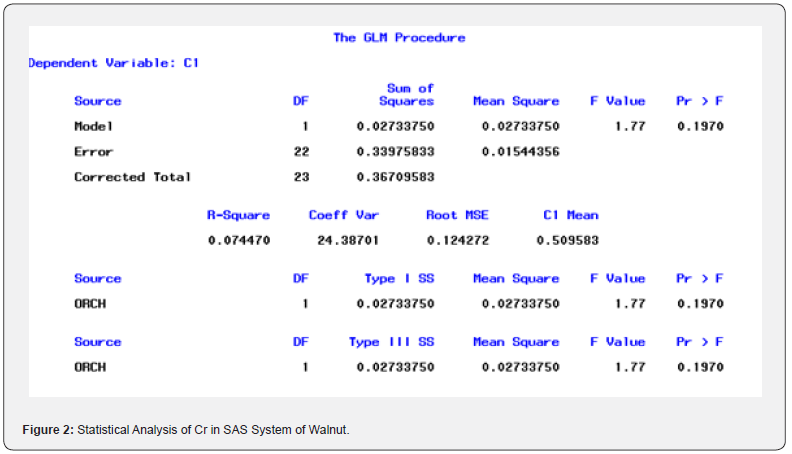
Concentrations of Major and Trace Elements in Walnut Leaves
TEs and major elements mean concentrations found in walnut leaves are summarized in Table 5. For the validation of the technique, it was used a standard reference material (SRM) NIST 1515 apple leaves. In addition, was made an addition of a standard solution, for the elements As, Cr, S, and Se which were not included in the certified values list. The recovery factors for the four added concentrations were 107.15% for As, 102.27% for Cr, 98.47% for S, and 98.91% for Se, this supports the good precision of the method used. Three replicates were analyzed for each sample, and all measurements had a good repeatability, which was of less than 10%.
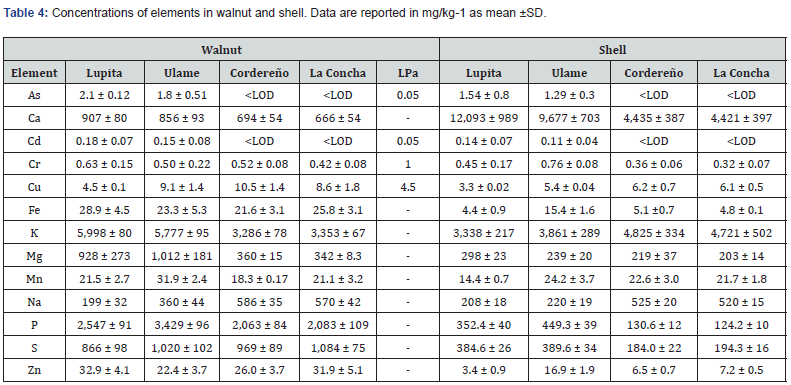
Note: Data is the mean of n=7. Pb, Sb, and Se were not detected. LPa = permissible limit (FAO/WHO, 2011).
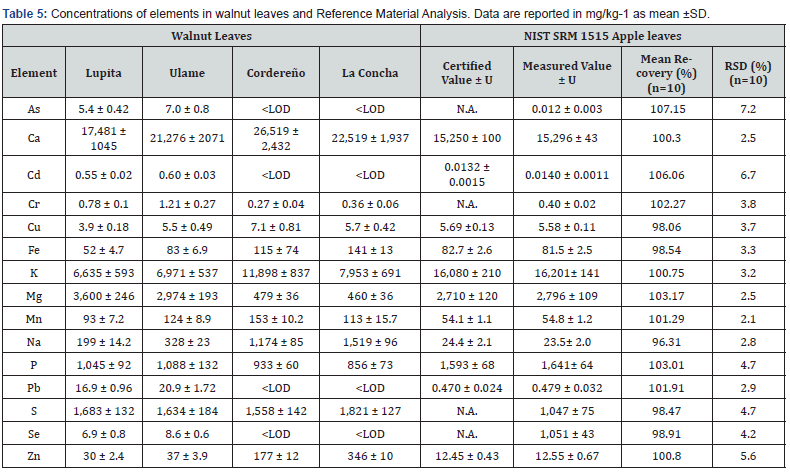
The TEs present in walnut leaves for the orchards Lupita and Ulame (sampling 2019) were As, Cd, Cr, Pb, and Se were found in a range between 5.4 and 7.0 mg*kg-1; 0.55 and 0.60 mg*kg-1; 0.27 and 1.21 mg*kg-1; 16.9 and 20.9 mg*kg-1; 6.9 and 8.6 mg*kg-1; which can be attributed to the main difference between the years of sampling, 2019 a year with high precipitation, and 2020 a drought year. Besides, the results showed that a drought year decreased the transfer of TEs from soil to plant. On the other hand, in the literature, As, Cr, and Pb were reported values in walnut leaves of 8.9 mg*kg-1; 53 mg*kg-1 and 10 mg*kg-1 respectively [20].
In addition, Cd was found in artichoke leaves in a concentration of 0.19 mg*kg-1 [29]. These values are similar to the found values of TEs in walnut leaves in the present study.
However only the analyte Cr was detected in the four orchards, the above can be attributed to this element can be dissolved in the soil at pH alkaline and be available to plants [20]. Another element found in a high concentration in walnut leaves in the present research is Na, in the literature, there is little information reported on this analyte in plants. The present study ranges from 199 to 328 mg*kg-1 in the orchards Lupita and Ulame, on the other hand, in the orchards Cordereño and La Concha the range was between 1,174 to 1,519 mg*kg-1, these values can be considered high. A study on walnut trees reports Na values in walnut leaves in a range of 232 to 563 mg*kg-1 [20]. The high concentration of Na in walnut leaves can be attributed to the transference from soil to walnut leaves, and to a harvest with poor quality, which was the case of the orchards Cordereño and La Concha, the walnut was partially dry.
Health Risk Assessment
The health risk implications were determined for carcinogenic risk, by walnut consumption.
Carcinogenic Risk Assessment
The CR values of As, Cd, and Cr are summarized in Figure 3. It is observed in Figure 3 the mean CR values of these TEs exceeded the threshold limit, and the ingestion of walnut produced in these orchards represents a potential carcinogenic risk for human health in the long term.
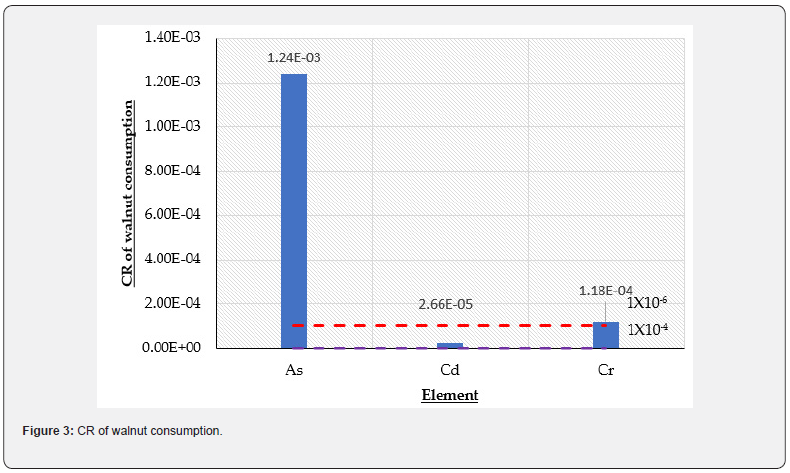
The TEs can have carcinogenic effects, this depends on the exposure dose. According to US EPA, there are three cancer risk levels to assess the CR of TEs. The first one is the CR < 10-6 which is the safe limit indicating that there is no risk, the second one is if CR is in the range of 10-6 to 10-4 which indicates an acceptable cancer risk, while CR > 10-4 is the threshold limit and it is considered unacceptable since it can represent a health risk for the population. The CRs in this research for the most contaminated orchards were As 1.24 x 10-3, Cd 2.66 x 10-5, and Cr 1.18 x 10-4. The CRs in this research for the most contaminated orchards were As 1.24 x 10-3, Cd 2.66 x 10-5, and Cr 1.18 x 10-4 respectively. The results of CR for As, and Cr should be a preoccupation because it raises serious health by walnut consumption produced in the studied areas in Chihuahua. The CR values of Cd were within the acceptable cancer risk. On the other hand, research on maize in China found CR for As (1.17 X 10-4), Cd (4.93 X 10-4), and Cr (2.74 X 10-4) [6]. A study in Bangladesh by Shaheen [30] reported a CR for As 1.5x10-8 for mango, 5.9 x 10-8 for bean, and 1.9 x 10-8 for carrot, respectively [31,32].
Conclusion
The present research assesses the health risk of walnut consumption through to TEs in the water-soil-tree interaction pollution pathway. The transfer of these elements increases the bioavailability of these TEs in food. The study’s results highlight the research’s scope of exposure to toxic elements. Walnut is consumed in low amounts; however, it has a very important contribution to the research of trace elements in agriculture. The CRs of the TEs: As, and Cr exceed the threshold limit, and therefore, are considered unacceptable (CR>10-4) and should be considered warrant concern. It can also be concluded, the difference in the dynamic of TEs in a year with high precipitation (2019) and a year with drought (2020), in the year with water deficit decreases the transference of toxic elements to the plants, however, only Cr was translocated even in a drought year. At last, it is suggested that the Mexican authorities establish permissible limits and legislation for TEs in food. On the other hand, Na can be absorbed by the walnut leaves in a ratio of four times more than it was in the rainy year, indicating a possible tendency of hyperaccumulation of Na due to drought conditions. This research provides a reference for similar studies around the world.
Acknowledgment
The authors are grateful for the technical support from CIMAV (Centro de Investigacion en Materiales Avanzados) and CONAHCYT.
References
- Alzahrania H, Kumakli H, Ampiaha E, Mehari T, Thornton A, et al. (2017) Determination of macro, essential trace elements, toxic heavy metal concentrations, crude oil extracts and ash composition from Saudi Arabian fruits and vegetables having medicinal values. Arabian Journal of Chemistry 10(7): 906-91.
- Basha AM, Yasovardhan N, Satyanarayana SV, Reddy GVS, Vinod KA (2014) Trace metals in vegetables and fruits cultivated around the surroundings of Tummalapalle uranium mining site, Andhra Pradesh, India. Trace metals in vegetables and fruits cultivated around the surroundings of Tummalapalle uranium mining site, Andhra Pradesh, India. Toxicology Reports 1: 505-512.
- Matos-Reyes MN, Cervera ML, Campos RC, De la Guardia M (2010) Total content of As, Sb, Se, Te and Bi in Spanish vegetables, cereals and pulses and estimation of the contribution of these foods to the Mediterranean daily intake of trace element. Food Chemistry 122: 188-194.
- Cervantes TA, Leal L (2022) Dynamics of Major and Trace Elements in Water-Soil-Tree Interaction: Translocation in Pyrus Malus in Chihuahua, Mexico Using ICP-OES and Its Health Risk Implications. Int J Environ Res Public Health 19(19): 12032.
- Pipoyan D, Stepanyan S, Beglaryan M, Stepanyan S, Asmaryan S, et al. (2020) Carcinogenic and non-carcinogenic risk assessment of trace elements and POPs in honey from Shirak and Syunik regions of Armenia. Chemosphere 239: 124809.
- Cao L, Lin C, Gao Y, Sun C, Xu L, et al. (2020) Health risk assessment of trace elements exposure through the soil-plan (maize)-human contamination pathway near a petrochemical industry complex, Northeast China. Environmental Pollution 263: 114414.
- Shi M, Chu Q, Wang X (2023) Probabilistic human health risk assessment of trace elements exposure in crayfish. Journal of Food Composition and Analysis 121: 105360.
- Kovacheva A, Vladov I, Gabrashanska M, Rabadijeva D, Tepavitcharova S, et al. (2020) Dynamics of trace metals in the system water-soil-plant-wild rats-tapeworms (Hymenolepis diminuta) in Maglizh area, Bulgaria. Journal of trace elements in Medicine and Biology 58: 126440.
- Wu S, Shen D, Wang R, Han Y, Zheng Y, et al. (2020) Evaluation of risk levels of trace elements in walnuts from China and their influence factors: Planting area and cultivar. Ecotoxicol Environ Saf 203: 110996.
- Praveena S, Omar N (2017) Heavy metal exposure from cooked rice grain ingestion and its potential health risks to humans from total and bioavailable forms analysis. Food Chem 235: 203-211.
- SAGARPA (2016) Chihuahua, líder nacional en producción de nuez. Reporte Informativo.
- CONAGUA (2023) Normales Climatológicas por Estado, Chihuahua.
- Renteria VM, Hanson R, Eastoe C (2022) Evaluation of climate variability on sustainability for transboundary water supply in Chihuahua, Mexico. J Hydrol Reg Stud 44: 101207.
- González VR, Montero M, Santana J (2018) Effects of climate change on the environmental flows in the Conchos River (Chihuahua, Mexico). Ecohydrol Hydrobiol 18(4): 431-440.
- Liu CD (2017) Bioaccumulation of heavy metals and health risk assessment in three benthic bivalves along the coast of Laizhou Bay, China. Mar Pollut Bull 117(1-2): 98-110.
- EPA, US (1997) Exposure Factors Handbook. EPA/600/P-95/002F. Integrated Risk Information System (IRIS) Chemical Asssessment Summary, Washington, DC, USA, 2023.
- EPA, US. Screening Level Ecological Risk Assessment Protocol for Hazardous Waste Combustion Facilities, Appendix E: Toxicity Reference Values. United States Environmental Protection Agency.
- EPA, US. Regional Screening Level (Rsl) Tapwater Supporting Table.
- EPA, US. Zinc and Compounds; CASRN 7440-66-6. Integrated Risk Information System (IRIS) Chemical Assessment Summary, Washington, DC, USA.
- Cervantes TA, Pinedo ÁC, Santellano EE, Cortes PL, Rentería VM (2018) Distribution of chemical species in the water-soil-plant (Carya Illinoinensis) system near a mineralization area in Chihuahua, Mexico - Health Risk Implications. International Journal of Environmental Research and Public Health 15(7): 1393.
- Alloway B (2013) Heavy metals in soils. In Trace metals and metalloids in soils and their bioavailability. Environmental Pollution.
- FAO (1985) Water Quality Water quality for agriculture. Rome: Food and Agriculture Organization of the United Nations.
- Ekholm P, Reinivuob H, Mattila P, Pakkala H, Koponen J, et al. (2007) Changes in the mineral and trace element contents of cereals, fruits and vegetables in Finland. Journal of Food Composition and Analysis 20(6): 487-495.
- FAO (1988) Saline soils and their management. Rome Italy.
- Beccaloni E, Vanni F, Beccaloni M, Carere M (2013) Concentrations of arsenic, cadmium, lead and zinc in homegrown vegetables and fruits: Estimated intake by population in an industrialized area of Sardinia, Italy. Microchem J 107: 190-195.
- FAO/WHO (2011) Report of the 33rd session of the codex committee on food additives and contaminants. Codex Alimentarius Commission [FAO/WHO], Food Additives and Contaminants. Join FAO/WHO Food Standards Program. ALINORM 01/12A 2005.
- Von Hoffen P, Säumel I (2014) Orchards for edible cities: Cadmium and lead content in nuts, berries, pome and stone fruits harvested within the inner city neighbourhoods in Berlin, Germany. Ecotoxicol Environ Saf 101: 233-239.
- Liang Y, Tian Q, Zhang S, Yin K, Qin J (2015) Determination of Trace Elements in Edible Nuts in the Beijing Market by ICP-MS. Biomed Environ Sci 28(6): 449-454.
- Machado I, Faccio RP (2019) Characterization of the effects involved in ultrasound-assisted extraction of trace elements from artichoke leaves and soybean seeds. Ultrason. Sonochemistry 59: 104752.
- Shaheen N, Irfan NM, Khan IN, Islam S, Islam MS, et al. (2016) Presence of heavy metals in fruits and vegetables: Health risk implications in Bangladesh. Chemosphere 152: 431-438.
- Conagua (2013) Ley Federal de Derechos, Disposiciones Aplicables en Materia de Aguas Nacionales; Agua, CND, Ed.; Gobierno de la Republica Mexico: Mexico City, Mexico; pp. 1-166.
- Funes PI, Salomon M, Gil R, Mastrantonio L, Bottini R, et al. (2018) Arsenic and trace elements in soil, water, grapevine and onion in Jáchal, Argentina. Sci Total Environ 615: 1485-1498.






























